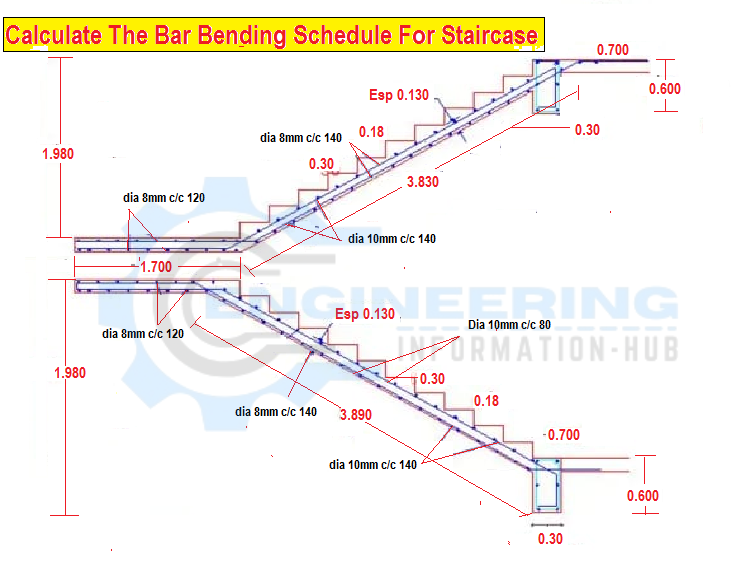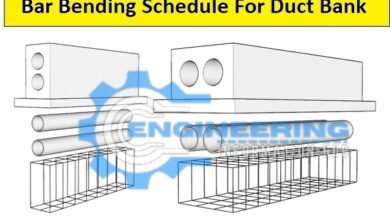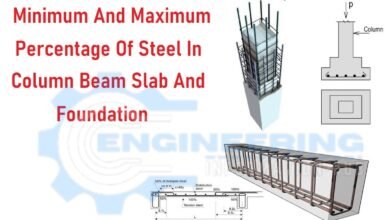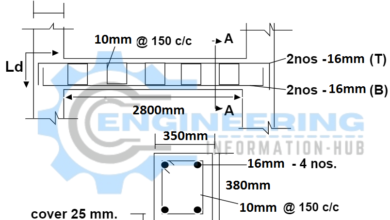Bar Bending Schedule For The Staircase

Bar Bending Schedule For The Staircase
Today In this article I will explain How To Calculate The Bar Bending Schedule For The Staircase | The meaning of the Bar Bending Schedule is the Detail of steel used in the staircase.
Bar Bending Schedule for Staircase
Given Data

Diameter of Distribution bar of Landing=8mm
Total length = 3.250m
Length of landing =1.700m
Width of Landing=1.500m
Spacing =120mm
Concrete cover=12.5mm
Solution
Length of Distribution Bar=Total Length – 2 Concrete cover
Length of Distribution Bar=3.250-2(12.5) =3.200m
Numbers of Distribution Bar=Total width /spacing+1
Numbers of Distribution Bar=1500/120 +1
Numbers of Distribution Bar=12.5+1=13.5 says 14 No’s
Total Number of Distribution Bar = Bottom distribution Bar + Top distribution Bar
Total Number of Distribution Bar =14+14=28 No’s
Total Length of Distribution Bar= Length of one bar x No’s of bar
Total Length of Distribution Bar=3.200 x 28 =89.6m
Weight Of Distribution bar for Landing
Weight of Distribution bar= d²/162.25 x total length
Weight of Distribution bar=(8)²/162.25 x 89.6
Weight of Distribution bar=64/162 x 89.6=35.34kg says 36kg
2-Waist slab

Given data
Diameter of Distribution bar = 8mm
Length of waist slab=3.890m+
Width of waist slab = 1.500m
Spacing of Distribution bar=140mm
Solution
Length of Distribution bar= width of the slab
Length of Distribution bar=1.500m
Numbers of Distribution Bar= length of Waist slab/spacing +1
Numbers of Distribution Bar=3890/140+1
Numbers of Distribution Bar=27.78+1= 28.78 No’s says 29 Numbers
Total Number of Distribution Bar = Distribution Bar bottom+ Distribution Bartop
Total Number of Distribution Bar =29+29=58No’s
Total Length of Distribution Bar = Length of one bar x No’s of Bar
Total Length of Distribution Bar =1.500 x 58= 87m
Weight of Distribution Bar for Waist Slab
Weight of Distribution Bar= d²/162.25 x total length of bar
Weight of Distribution Bar= (8)²/162.25 x 87
Weight of Distribution Bar=64/162.25 x 87 =34.31kg says 35kg
3-Main bar Bottom Area
Given data
Diameter of main bar=10mm
Spacing =80mm
Length of waist slab= L.W = 3.890m
Height of Riser= R.H=180mm
Width of landing=W.L=1.500
Width of bottom beam=W.B=0.300m
Height of bottom beam=H.B= 0.440M
Solution
Length of main bottom bar =L.W+W.L+W.B/2 + H.B+ diameter of bar –R.H
Length of main bottom bar = 3.890+1.500+0.300/2+0.440+0.010-0.180
Length of main bottom bar =5.81m
Number of main bottom bar= Total width of slab/ spacing +1
Number of main bottom bar= 1500/80+1 =19.75=20 No’s
The total length of the main bottom bar = length of one bar x number of bar
Total length of main bottom bar =5.81 x 20 =116.2m
Weight of Main Bottom Bar
Weight of main bottom bar =d²/162.25 x total length
Weight of main bottom bar = (10)²/162.25 x 116.200
Weight of main bottom bar =100/162.25 x 116.200 =71.61kg =72kg
4-Main Top Bar
Given data
Diameter of main bar=10mm
Spacing =80mm
Length of waist slab= L.W = 3.890m
Height of Riser= R.H=180mm
Length of landing=L.L=1.500
Width of bottom beam=W.B=0.300m
Height of bottom beam=H.B= 0.440M
Solution
Length of Top Main Bar= L.W + L.L + H.B + Diameter of bar +(W.B-2C.C)-R.H
Length of Top Main Bar=3.890+1.7+0.440+0.010+(0.300-2(12.5)-0.180
Length of Top Main Bar=6.11m
Number of Top Main Bar = Total width of slab/spacing +1
Number of Top Main Bar =1500/80+1=19.75=20No’s
The total length of the top main bar= length of one bar x No’s of bar
Total length of top main bar=6.11 x 20 =122.200m
Weight of Top Main Bar
Weight of Top Main Bar= d²/162.25 x total length
Weight of Top Main Bar = (10)²/162.25 x 122.20
Weight of Top Main Bar = 100/162.25 x 122.20 75.315kg= 76kg
This is 1st slab Bar Bending Schedule.
Now
Same Step Calculation for 2nd slab Bar Bending Schedule.
1-Waist slab
Given data
Diameter of Distribution bar = 8mm
Length of waist slab=3.830m+
Width of waist slab = 1.500m
Spacing of Distribution bar=140mm
Solution
Length of Distribution bar= width of the slab
Length of Distribution bar=1.500m
Numbers of Distribution Bar= length of Waist slab/spacing +1
Numbers of Distribution Bar=3830/140+1
Numbers of Distribution Bar=27.35+1= 28.35 No’s says 29 Numbers
Total Number of Distribution Bar = Distribution Bar bottom+ Distribution Bartop
Total Number of Distribution Bar =29+29=58No’s
Total Length of Distribution Bar = Length of one bar x No’s of Bar
Total Length of Distribution Bar =1.500 x 58= 87m
Weight of Distribution Bar for Waist Slab
Weight of Distribution Bar= d²/162.25 x total length of bar
Weight of Distribution Bar= (8)²/162.25 x 87
Weight of Distribution Bar=64/162.25 x 87 =34.31kg says 35kg
2- Main bar Bottom Area
Given data
Diameter of main bar=10mm
Spacing =80mm
Length of waist slab= L.W = 3.830m
Height of Riser= R.H=180mm
Width of landing=W.L=1.500
Width of bottom beam=W.B=0.300m
Height of bottom beam=H.B= 0.440M
Solution
Length of main bottom bar =L.W+W.L+W.B/2 + H.B+ diameter of bar –R.H
Length of main bottom bar = 3.830+1.500+0.300/2+0.440+0.010-0.180
Length of main bottom bar =5.750m
Number of main bottom bar= Total width of slab/ spacing +1
Number of main bottom bar= 1500/80+1 =19.75=20 No’s
The total length of the main bottom bar = length of one bar x number of bar
Total length of main bottom bar =5.750 x 20 =115m
Weight of Main Bottom Bar
Weight of main bottom bar =d²/162.25 x total length
Weight of main bottom bar = (10)²/162.25 x 115
Weight of main bottom bar =100/162.25 x 115 =70.878kg =71kg
3-Main Top Bar
Given data
Diameter of main bar=10mm
Spacing =80mm
Length of waist slab= L.W = 3.830m
Height of Riser= R.H=180mm
Length of landing=L.L=1.500
Width of bottom beam=W.B=0.300m
Height of bottom beam=H.B= 0.440M
Solution
Length of Top Main Bar= L.W + L.L + H.B + Diameter of bar +(W.B-2C.C)-R.H
Length of Top Main Bar=3.830+1.7+0.440+0.010+(0.300-2(12.5)-0.180
Length of Top Main Bar=6.050m
Number of Top Main Bar = Total width of slab/spacing +1
Number of Top Main Bar =1500/80+1=19.75=20No’s
The total length of the top main bar= length of one bar x No’s of bar
Total length of top main bar=6.050 x 20 =121m
Weight of Top Main Bar
Weight of Top Main Bar= d²/162.25 x total length
Weight of Top Main Bar = (10)²/162.25 x 121
Weight of Top Main Bar = 100/162.25 x 121= 74.576kg= 75kg
Now
Bar Bending Schedule for Beam
Given data
Diameter of Ring= 8mm
Diameter of bar= 12mm
Spacing=200mm
Length of column =1.5m
Height of Column= 600mm
Concrete cover of column =25mm
Breath of column=300mm
Learn More
Bar Bending Schedule B.BS
How To Estimate Per Meter Weight Of Reinforcing Bar
Solution
Length of main bar = length of column – 2c.c +2 bends(19d) -2dia of bar
Length of main bar =1.5-2(0.025) + 2(19×12)-2(12)
Length of main bar =1.5.-0.050+0.456-0.024=1.882m
Number of main bar= total length / spacing +1
Number of main bar = 1500/200+1=7.5+1=8.5= 9 no’s
The total length of the main bar= length of one bar x No’s of bar
Total length of main bar=1.882 x 9 =16.938m
Wight of the main Bar
Wight of main bar = d²/162.25 x total length
Wight of main bar = (12)²/162.25 x 16.938
Wight of main bar= 144/162.25 x 16.938= 15.03kg =15kg
Ring of column
Length of ring = 2 length +2 breath +2 hooks -3 diameter of bar – 4c.c
Length of ring =2(600) + 2(300)+2(9d)-3(8)-4(25)=1820mm=1.820m
Number of rings= total length /spacing +1
Number of ring = 1500/140+1=11.71=12 No’s
The total length of ring= length of one ring x no’s of ring
Total length of ring = 1.820 x 12 =21.84m
Weight of ring
Weight of ring = d² /162.25 x total length
Weight of ring = (8)²/162.25 x 21.84 =8.61kg = 9 kg
Total weight of 8mm bar
1st step = 36+35
2nd step= 35
Column =9
Total 36+35+9= 80kg
Total weight of 10mm bar
1st step =72+76 =148kg
2nd step = 71+75=146kh
Total =148+146= 294kg
Total weight of 12 mm bar
Column bar 12mm = 15kg
Learn More
Stairs Types Of Stairs and Principles of Designing of Stairs
Calculate The Quantity of Items of Staircase
How To Estimates The Concrete Volume Of Staircase
Bar Bending Schedule For The R.C.C Beam
Thanks for Reading Article Get more Information and share it with others.
JOIN US & LIKE MY OFFICIAL FACEBOOK PAGE
THANKS







3 Comments